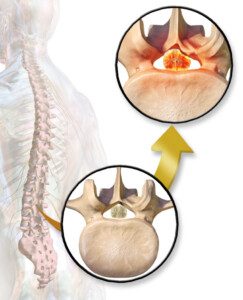
As spinal stenosis progresses, the patient gets increasingly hunched over when walking.
“Spinal stenosis is a common problem that develops in the spine as we age,” says Dr. Nick Jain, MD, a board certified and fellowship trained orthopedic spine surgeon at DISC Sports & Spine Center in Newport Beach, CA.
“Oftentimes, we notice, as people with spinal stenosis start to hunch forward or their neck begins to tip forward.
“This typically occurs in the neck and low back as flexion (leaning forward) actually relieves spinal stenosis and provides more room for the spinal canal, and the body and nerves tend to prefer being in these positions when stenosis exists.”
Wouldn’t repeatedly standing straight help reverse this situation or at least make erect posture more tolerable?
“Stand up straight!” my mother has often told my father, who has spinal stenosis.
It’s not uncommon to see senior age people walking with the distinct hunching over of spinal stenosis (narrowing of the spinal canal through which the spinal cord fits).
Hunching over is called lumbar flexion and relieves the pain, which is why patients do this.
There is actually nothing mechanical blocking their ability to straighten out more.
However, this doesn’t mean in severe cases that they can straighten out all the way and stand perfectly vertical.
In my father’s case he can straighten to nearly vertical but claims that this position is intolerable. But when he lies on his back in bed, his back is perfectly straight.
“Extension (leaning back) and trying to stand very erect with good posture can actually compress the nerves and be more painful for people with spinal stenosis,” continues Dr. Jain.
Walking straight for some patients is so painful that they maintain a marked slump while walking even short distances.

Spinal stenosis. Blausen.com staff/Bruce Blausen CC BY 3.0 creativecommons.org/licenses/by/3.0/Wikimedia Commons
From an intuitive standpoint, it seems as though an effective exercise would be to stand in one spot and very briefly straighten (extend), to retrain the back for good posture and strengthen the lumbar area.
It seems logical that over time, the duration of extension would increase due to a higher tolerance of this position that would come with time.
But what seems logical or intuitive isn’t always the reality.
“So, in short, for some people with spinal stenosis, trying to stand up straight probably should be avoided if it leads to increased pain,” says Dr. Jain.
“Forcing an erect posture can be dangerous for someone with spinal stenosis in the neck or low back, as it can actually kink the spinal cord or the nerves passing through the spinal canal — and should generally be avoided, as it would be unlikely to remodel the spine.”
“However, some people are hunched forward due to a spinal deformity that may be fixed or mobile.
“For people with these issues, core strengthening exercises and trying to maintain an erect posture may help eliminate pain and symptoms, as the body has a natural ‘cone of efficiency,’ and leaning or falling forward (i.e., bad posture) requires a lot of energy expenditure by the body and often induces pain.
“But people with spinal deformities without stenosis may benefit from exercises to improve their posture.”
Is it spinal stenosis or a spinal deformity?
Dr. Jain explains, “An evaluation by a professional can help distinguish between these two situations, as sometimes a small, minimally invasive treatment for spinal stenosis (such as an epidural injection or decompression surgery) can allow someone to stand up straighter and taller by alleviating the stenosis.
“However, people with spinal deformities often need surgical treatment to realign the spine and secure it in the proper place and alignment.
“Consult with an expert for your specific situation before forcing the neck or low back into a certain position, especially if that position causes discomfort, numbness or tingling.”
To put this succinctly, you can’t work out spinal stenosis.

 Dr. Jain
Dr. Jain 
























